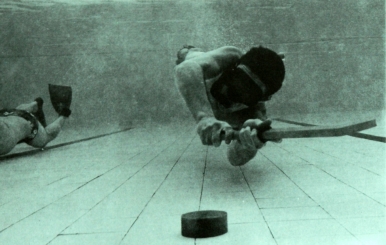Underwater Hockey began in South Africa during the summer of 1961/62 following an article in the October 1961 issue of the American Skin Diver magazine. The article showed scuba divers playing hockey in a pool using ice hockey sticks.
The exact origin of South African Underwater Hockey remains a controversial subject, but we believe that Durban Undersea Club and Normalair Underwater Club share that honour, as well as that of developing the game and organising the first inter-club championship.
Associated Divers and Wahoos joined Durban Undersea Club and began playing three way club games on a monthly basis. Contact with Normalair resulted in an invitation to the Transvaalers to pit their skills against the Durban teams.
Thus the first Inter-Club Championship took place over the Easter weekend in 1964 and involved Associated Divers A, Durban Undersea Club A and B, Normalair A and B and Wahoos A. The tournament took place at the Lido Hotel (now Aliwal Cove) in Umkomaas and the winners of the A and B sections were Normalair.
The next Inter-Club took place in Johannesburg the following year and a tournament has been held very year since. The first time that the tournament moved from either Johannesburg or Durban was in 1968 when it was held in Kimberley. The water was so cold that the players wore wetsuits.
In 1974 a separate women’s section was introduced to the Inter-Club Champs and in 1980 the first Inter-Provincial for women was held.
The first Inter-Provincial Tournament took place in Bloemfontein in conjuction with the Republic Festival Games in 1969. The next took place in 1971 in Cape Town followed by an Inter-Provincial every year since.
International Profile
In 1971 at the Republic Sports Festival held in Cape Town a South African team was selected to play against an invitation team. In 1974 SAUU sent a team to play against Rhodesia in Salisbury and Kariba. In 1975 a Springbok Orienteering Team travelled to Europe with a view to promoting hockey internationally. The team played mixed games against U.K. club teams and demonstration games in France. They then played against Holland in a game that was billed as the first ever International match.
In 1977, following a proposal from SA at the CMAS World Federation meeting, the inaugural meeting of the CMAS Games Commission was held at Fort Bovisand in Plymouth England. This meeting was attended by Owen Bruyns and Des Dandridge of SA and firmly entrenched SA as founder members of this commission. One of the results of this international contact was an invitation to send the first Springbok hockey team to play against England.
The 1977 touring team visited England, Holland, France, Italy and Isreal where they played Internationals against England and Wales, and friendlies and demonstration games in the other countries. The tour was reciprocated in 1979 when an English team visited SA and played the second official Springbok side.
In 1980 a World Championships was held in Canada. South Africa was not invited due to the political pressure applied to the hosts and other participating countries. The tournament was therefore technically “unofficial” but all the participants considered the winners as World Champions.
The following year SA offered to host the World Champs and received a very good initial response but one by one countries were forced to withdraw due to the intense political pressure. In compensation the Springbok men and women teams played against invitation teams at the SA Festival Games held in Durban in May 1981.
England visited South Africa in 1985 and introduced the one-handed game of Octopush (as they call it). All the tests were played with the short stick (as played currently).

Two handed Underwater Hockey
The game in South Africa subsequently changed from the long stick (two handed) to the short one-handed stick at the beginning of the 1985/86 season. The first Inter-Club tournament using the short stick was in 1985 and the first national tournament in 1986.
South Africa visited England in 1987 with a men’s Springbok team, a men’s SAUU development team and the first ladies’ Springbok team. A ladies Springbok team toured England and France in March 1990. A men’s Springbok team toured England and France in May 1990. South Africa was invited by CMAS to participate in the 1992 World Championships in New Zealand, and sent a men’s and ladies’ Springbok team.
In 1993 South Africa were guests at the Trans-Tasman Tournament in Australia. At that tournament South Africa, Australia and New Zealand drew up the Guidelines for the Southern Hemisphere Championships, the first of which was held in Wellington in 1995.
In 1996 South Africa hosted the World Championships in Durban.
Early South African Rules (1964 – 1979)
(These few are the more interesting ones, which have changed or been dropped.)
The stick is a piece of wood in the shape of a hockey stick 20″ long from the curve to the end of the handle. Markings to be made 11″ from the end of the handle to indicate the lowest playing position.
The puck shall only be played with the curved end of the stick with both hands, and both hands above the markers on the sticks.
A goal shall be scored by hitting the opposing wall with the puck, which must then be picked up by the goal scorer and put on the side of the bath, otherwise goal disallowed.
When the puck has touched the wall it is dead, and play shall cease.
Any player deliberately seen fouling shall be made to tread water for a given time.
This article is extracted from the South African Underwater Hockey Manual, first edition, 1993.